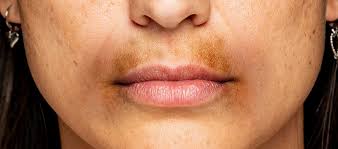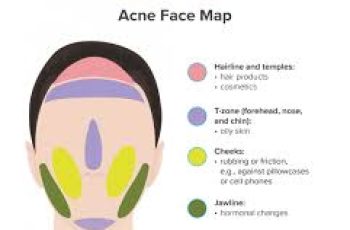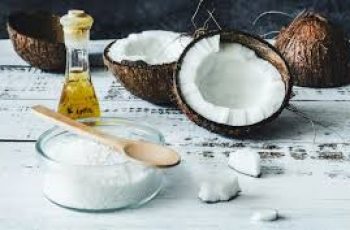How to fight hyperpigmentation around the mouth?
Fighting hyperpigmentation can be quite daunting, but it has become much more treatable in recent years. There are a number of products with all skin ingredients that can help fight dark spots on the skin and make them look less noticeable. There are different levels of hyperpigmentation on the skin, ranging from scars left by acne to damage caused by excessive UV radiation. Some people also find that lifestyle changes can lead to uneven skin tone. While this is a harmless skin problem, it can be quite bothersome, especially when it is concentrated in the mouth area. So today we are taking a look at how to fight hyperpigmentation around the mouth.
If you want to learn how to fight dark spots on the skin, you can read our dedicated blog post on which skin care tips can help you keep them under control.
How to whiten the skin around the mouth?
We all get our skin pigment from melanin, which is naturally produced in the skin. Often, damage occurs from excessive sun exposure, medications, hormonal changes (such as pregnancy), and other underlying medical conditions that can cause imbalances in the skin.
Here are some skin care measures you can take to reduce the appearance of hyperpigmentation and prevent it from returning:
Use skin care products rich in antioxidant ingredients to help fight free radical damage caused by factors such as UV radiation, pollution, and other environmental aggressors.
Incorporate chemical peels into your daily routine. Glycolic and lactic acids remove dead skin cells that build up on the outer surface of the skin. Over time, you will notice that any dark pigmentation will be significantly lighter.
Make sure to cleanse your skin thoroughly during your evening skin care routine to prevent residual product from causing breakouts and other skin damage.
Depending on your skin type, you can use scrubs and exfoliators 2-3 times a week.
These are some of the best skin care tips to help whiten the skin around your mouth and reduce pigmentation.
What causes dark spots around your mouth?
Here are some of the main factors that can cause pigmentation around your mouth and how long they may last on your skin:
Skin trauma
I am referring to any type of skin injury, such as acne, spots, infections, or burns. Once these issues heal, dark brown spots can appear around your mouth, which is often called post-inflammatory hyperpigmentation. So if there is inflammation in the area, there is a good chance that dark spots will appear. However, there is no need to panic as these dark spots usually disappear after about 6 months. However, if you want to clear these spots on your skin faster, you can use a serum rich in antioxidant ingredients such as vitamin C to quickly reduce the appearance of spots.
Melasma
Melasma often appears during pregnancy and is often called the “mask of pregnancy.” It appears as brown, gray spots on the forehead, cheeks, and upper lip. Melasma is caused by hormonal changes and can affect pregnant women and some people who take certain types of oral contraceptives. These dark spots on the skin will not last forever, and you can expect them to decrease and eventually disappear a few months after the baby is born or after you stop taking birth control pills.
Sunlight
Overexposure to the sun’s UV rays increases the risk of developing dark spots. Also known as age spots, sun spots, and liver spots, these spots usually appear as the skin ages and cannot cover up damage caused by UV radiation from the sun or excessive use of tanning beds. However, keep in mind that if the damage is very severe, you will see signs of pigmentation before your skin ages further.
The most effective way to prevent these dark spots is to wear a sunscreen with SPF 30 or higher every day, even when the weather is cloudy. UVA rays are always present and using a sun protection factor creates a protective barrier on the skin. Don’t forget to apply sunscreen on your upper lips and around your mouth (make sure to apply sunscreen on your upper lips and around your mouth as this area is often forgotten and has the most pigmentation.
Vitamins and medical causes
Vitamin deficiencies, especially vitamin B12 and vitamin D, can contribute to the formation of melasma on the skin. Taking supplements every day can help keep your skin even and radiant. Uneven skin tone can become a problem if you have to take certain types of medication, although the effects may be short-lived and will hopefully improve after a few months.
These are some of the causes of hyperpigmentation on the skin. I will now explain to you the best treatments and ingredients that can be used to combat dark spots around the mouth and other areas of the skin.
What are the best treatments for hyperpigmentation on the face?
We have provided you with some skin care tips that can help you reduce the appearance of hyperpigmentation, which you can use on a daily/weekly basis. The following tips come from trained professionals and contain active ingredients that you need to gradually introduce into your daily routine, such as:
Video xanthocyanin, over-the-counter, medical-grade or prescription
Laser therapy for targeted treatment of dark spots and acne scars
Chemical peels aim to reduce the appearance of pigmentation through intensive exfoliation
Taking the time to find the best treatment and routine to combat hyperpigmentation can keep your skin feeling comfortable and looking healthy.
Will hyperpigmentation go away?
There are different types of hyperpigmentation. As mentioned, melasma will fade over time, while other dark spots can be treated with a tailored cocktail of treatments. Sun damage is notoriously difficult to eliminate, and while these particular dark spots may become less noticeable, they will never completely disappear. This means you need to remember to protect your face during the summer to prevent the pigmentation from darkening again.
How long does it take for hyperpigmentation to fade?
Hyperpigmentation and dark spots on the face and mouth can take 6-12 months to disappear. As I mentioned before, there are some effective skincare ingredients you can incorporate into your daily routine to combat these issues. If you find that your hyperpigmentation is deeply rooted in the underlying layers of your skin, it may take years for the discoloration to improve.
I hope we answered your hyperpigmentation questions today. Don’t forget, you can always ask us any skincare-related questions on our Instagram.
DQH Knowledge drop: In your 20s, your skin cell turnover decreases. (Cell turnover is a key component in keeping your skin youthful.) You know what else slows down? Your collagen production. Starting in your 20s, collagen decreases by about 1 percent per year. Should you want to prevent fine lines and wrinkles, start by eliminating behaviors that contribute to premature aging. “If it’s bad for you, it’s bad for your skin,” says dermatologist Michel Somenek.
“Cigarette smoking reduces blood flow to the skin and causes premature wrinkling and a dull skin texture. Making the repeated pursed motion to inhale can also cause smoker’s lines. Alcohol and recreational drugs are toxins for the skin that damage its cellular structure and DNA,” Somenek tells us. “The faster you eliminate vices while you are young, the better chance your skin and body have to recuperate.” Also, adopting an anti-aging routine in your 20s is key. After all, the best offense is a good defense. We spoke to Somenek and experts Joshua Ross and Audrey Kunin to find out more.
Keep reading for the best anti-aging products for your 20s, according to skincare professionals.
Sunscreen
“We all know that the sun is the number one cause of skin aging and starting the prevention in your 20s is very important,” Ross says. “The majority of your sun damage won’t start to appear until you’re in your 30s, so don’t wait until you see it surface or you’ll be behind the curve. Stay ahead of it with a good-quality zinc-based sunscreen worn daily.”
Farmacy Green Defense Daily Mineral Sunscreen
An invisible sunscreen with SPF 30, plus botanical extracts meant to protect skin with tons of antioxidants. Bonus: It’s clean and fine to use under makeup.
Bareminerals Complexion Rescue™ Tinted Moisturizer Broad Spectrum SPF 30
Although we recommend you use your SPF and moisturizer separately, we also understand moments when you don’t have time or energy for that extra step. For those times, this bareMinerals moisturizer is a great thing to have on hand.
Vitamin C Serum
“A great introduction to anti-aging is to start with a vitamin C serum in your morning skincare routine,” Ross says. “It’s a powerful antioxidant that will neutralize free radicals and brighten the skin.” He adds that it’s a great way to counteract the effects of the sun’s harmful rays, which, as previously mentioned, are among the biggest causes of premature aging.
Drunk Elephant C-Firma™ Vitamin C Day Serum
The Drunk Elephant C-Firma is a lightweight serum that promises to give skin a glow by combining the brightening powers of vitamin C with ferulic acid, l-ascorbic acid, and vitamin E. The included sodium hyaluronate is meant to replace hydration loss, so you shouldn’t have to deal with any irritation.
Sunday Riley C.E.O. Rapid Flash Brightening Serum
This potent serum is jam-packed with vitamin C (15 percent, to be exact), which means it’s a potential superstar at both brightening skin and dousing it in antioxidants.
Peptides
Using peptides on your skin has many benefits, says Somenek. “The skin barrier is what defends the body against pollution, UV rays, bacteria, and toxins. It can be damaged by several everyday factors. Using topical peptides aids in building a stronger barrier,” he says. “Peptides comprise elastic fibers, which are a type of protein. These fibers help to make skin appear taut and firm. Peptides can also help repair damaged skin, relieve inflammation, and even out skin tone. Some peptides can kill acne-causing bacteria that is common in 20-somethings.”
Kunin agrees, saying, “Peptides are an excellent entry point for supporting collagen.” She recommends looking for face and eye treatments that contain these collagen-boosting powerhouses.
Charlotte Tilbury Magic Eye Rescue Cream
This Charlotte Tilbury super-emollient eye cream has a base of coconut oil and shea butter (read: it’s incredibly hydrating). Botanicals plus peptides are meant to help reduce dark circles and boost collagen, respectively.
This creamy moisturizer serves up potent collagen-boosting peptides and pycnogenol, and antioxidant-rich vitamin C. “Instead of sitting on top of the skin, peptides penetrate the outer layer so they go deep. The ‘signals’ they send tell the cells to produce elastin and collagen, which are needed for youthful-looking skin,” explains Somenek.
At-Home Peel Pads
Remember that skin cell turnover fiasco we talked about earlier? One way to help support it is by exfoliating. “Exfoliation is important to help keep skin fresh and luminous,” Kunin says. She recommends using at-home peel pads as an easy and effective way to exfoliate.
“The goal in your 20s is to fight the slowing pace of cell turnover. It is wise to use products that gently exfoliate, yet still remove oil and other impurities. Products that have Alpha Hydroxy Acids (AHA) or Beta Hydroxy Acids (BHA) are a good choice.”
According to Somenek, you should only exfoliate two to three times a week. “People of all ages are guilty of over-exfoliating and that can be too much of a good thing,” he says.
Dermadoctor Kakadu C Intensive Vitamin C Peel Pad
A few swipes of this Derma Doctor powerful peel pad promise to leave your skin glowing and smooth, thanks to the seven (yes, seven) types of chemical exfoliants, including AHA and BHA. It also contains vitamin C via Kakadu plum extract for added brightening and antioxidant protection.
KEY INGREDIENTS Kakadu plum extract is sourced from the Kakadu plum, a fruit grown in northern Australia. It contains vitamin C, which restores the skin’s natural barrier, increases collagen production, and soothes irritation.
Dr. Dennis Gross Skincare Alpha Beta® Universal Daily Peel Pads
These are the gold standard of peel pads, with a cult following and over 900 five-star reviews on Sephora. They’re easy to use and contain a blend of anti-aging exfoliating acids.
Emollient Night Cream
“In your 20s, you need to start upping the hydration in your skincare routine. You may have been cautious of over-moisturizing because of acne in your teens, but as you enter your 20s, your skin transitions and becomes drier,” Ross says. “I recommend an emollient night cream added into your evening skincare regimen.”
“Twenty-somethings need to make sure that they are not using creams that will clog their pores and cause excess oil production,” says Somenek. Opt for non-comedogenic products.
Cerave Skin Renewing Night Cream
One great choice is the CeraVe Skin Renewing Night Cream, which is a non-comedogenic night cream that leaves skin soft and glowy. It combines the moisturizing powers of ceramides and hyaluronic acid.
RoC Retinol Correxion Max Hydration Creme
“The best night cream ingredients contain retinol, benzoyl peroxide, and/or salicylic acid or hyaluronic acid. The goal is to moisturize, yet remove excess oil,” says Somenek. This Roc Retinol Correxion cream fits the bill as it contains both hyaluronic acid and retinol so it promises to moisturize while also being non-comedogenic.



